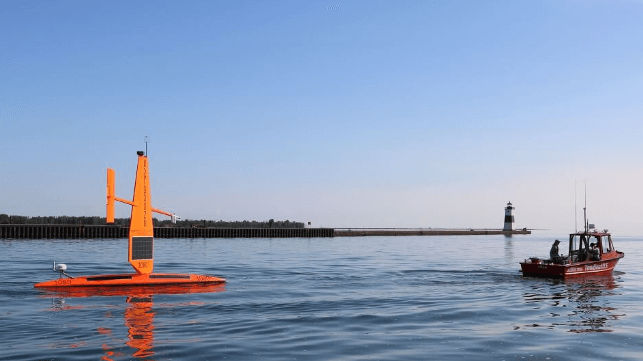GOOD DRONES
Next Stop for Saildrone Surveys: Lake Erie

The Saildrone autonomous surface vessel has operated on scientific and military missions around the world, from the Bering Strait to the Eastern Pacific to the Persian Gulf. Saildrones have even braved the full force of hurricanes to collect unpredented data for the National Oceanic and Atmospheric Administration. This summer, they can be spotted in a new location: Lake Erie, where the U.S. Geological Survey is using saildrones and underwater vehicles to conduct fisheries surveys. It is the first time that wind-powered autonomous boats will be used on the lake.
On July 14, USGS launched a Saildrone Explorer in Erie, Pennsylvania. This unit - in trademark safety orange - is equipped with sensors above and below the waterline, and will make extensive use of a hull mounted fish-finding echosounder. Saildrone will operate the wind-driven, solar-powered boat on behalf of USGS. Saildrone hull 1080 will make a circuit around Lake Erie for the next two months, carrying out a complete regional survey.
Monterey Bay Aquarium Research Institute (MBARI) will also deploy a long-range underwater autonomous vehicle for a weeklong survey off Fairport Harbor, Ohio.
“Monitoring Lake Erie fish populations is integral to sustainable management of the recreational and commercial Lake Erie fishery, but fish community changes and dynamic habitat conditions often create monitoring challenges. We are excited to collaborate with the USGS to explore the use of autonomous vehicles for monitoring Lake Erie fish populations and fisheries," said David Nihart, the state of Pennsylvania's fisheries chief and the chair of the Lake Erie Committee for fisheries management.
USGS asks boaters and mariners to keep 1,500 feet clear of the saildrone as it works its way slowly around the lake. The U.S. Coast Guard his issued notices to mariners about the saildrone's operations to give advance warning of its passage.
The reason for using a Saildrone in this application is unique. Traditionally, fisheries surveys have been done with diesel-powered research vessels. The noise of the engines and propellers affects fish behavior, and the researchers hope that the near-silent Saildrone may spot fish that a research vessel would miss.
No comments:
Post a Comment